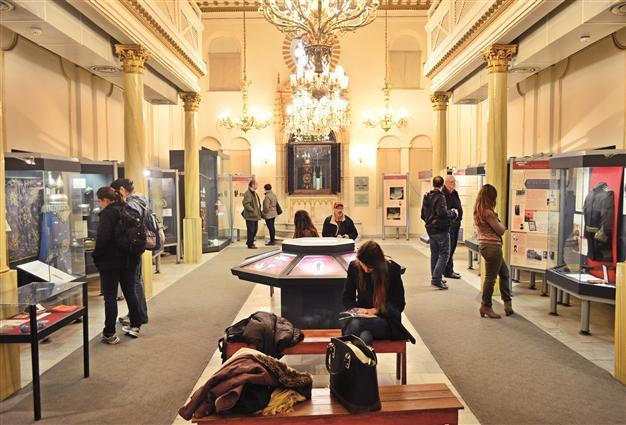Hidden treasure: The Quincentennial Turkish Jewish Museum
ISTANBUL - Anatolia News Agency

The Quincentennial Turkish Jewish Museum in Istanbul exhibits many important details on Jewish community culture in Turkey. AA Photo
Istanbul’s Quincentennial Turkish Jewish Museum is one of the hidden museums of the city, which stands in Karaköy Square at Hırdavatçılar bazaar. The building, which is 342 years old, is a synagogue that served the city’s Jewish community under the name of the Zülfaris Synagogue between 1671 and 1985. The museum tells the stories of Turkey’s Jews.The founder of the museum, writer and historian Naim Güleryüz, said that while the museum is not a Louvre or Topkapı Museum, it has its own distinctive voice.
In 1492, 120,000 Jewish people were forced to leave Spain and later on Sultan Bayezid II welcomed 90,000 of them to the Ottoman Empire. The Jewish people who settled began to spread to different parts of the Empire, bringing with them their distinctive culture and knowledge.
In 1992, 500 years after the Jewish people first came to the Ottoman Empire, the museum was been established. This historical episode for the Jewish people was commemorated by the founding of the museum, said Güleryüz. The aim of the establishment of the museum was to thank the Turkish nation and recognize their humanist approach.
The sections of the museum include different artifacts corresponding to different areas. It is impossible to see the entrance unless a visitor goes down the dead-end Perçemli Street. The entrance of the garden reveals an inscription from the Torah, “Your will protects the city’s peace and pray to God for this.”
After entering through this door, the visitor reaches a room used to for praying. This part is the ethnographic section of the museum and contains a chest, which is a symbol of marriage.
Many photographs are displayed on the walls of the museum. These photos depict many marriages, which took place from Edirne to Gaziantep, between the years of 1876 to 1976. The people in these photographs are dressed up in traditional clothes from old times and reflect the traditions of the Jewish people.
In this section the room also contains a large chair, used for the circumcision ceremony. “When some of the Muslim visitors see that chair, they are amazed to see that we have circumcision,” Güleryüz said.
The exhibit also provides information about Jewish weddings. The museum also gives examples of the similarities between Turkish and Jewish traditions.
The museum promotes, both within the country and abroad, the story of 700 years of amity between Turks and Jews. It also shows how the two cultures have influenced each other over the past 700 years, and also conveys the humanitarian spirit of the Turkish nation.
After the ethnographic area of the museum, the visitors are directed to the upper part of the building and into the second room. At the entrance of this room, a photo of Albert Einstein is displayed.
In all the Jewish Museums on the world there is a genocide corner, Güleryüz said. However, “in this museum we have an ‘honor’ corner because we did not experience that during the Second World War,” he added.
The museum also exhibits a copy of the letter from Einstein to the president of the Turkish Republic during that time, saying that Turkey should open its arms to Jewish academics. Many Turkish diplomats rescued Jewish academics from the concentration camps in Europe with Turkish passports. The Jewish academics are displayed and commemorated in the museum.
The yellow stars that Jewish people were obliged to wear are also displayed in the museum, revealing the suffering that they had to endure.
The most valuable and most important piece of the museum is its Hanukkah chandelier, Güleryüz said. The chandelier was unsurprisingly made by a Jewish craftsman during 19th century. On one part of the chandelier a crescent-shape can be seen, while another part shows a moon and stars. Such chandeliers have a central place in the ceremonies during the Hanukkah festival of the Jewish people.
The most valuable piece in the museum
“These chandeliers are the most valuable pieces in the museum and also reflect and symbolize how people gather for God,” said Güleryüz. The oldest object in the museum is a book published in 1512, “Complete works of an epic: Midrash Tehillim.” The work was found in Germany and put in the museum, said Güleryüz. “We have gathered lots of valuable objects from Jewish families which we begged them to donate to us because we wanted to exhibit the lives of Jewish people,” he said, adding that they have preserved the objects for 700 years with pride.Visitors learn many things from the museum, he said, adding that the two societies did not know enough about each other. All the prejudices should end, he said.
Visitors to the museum
The museum attracts many visitors from all around the world. There are people visiting from Chile and Japan. A total of 10,000 people visit the museum per year.
The museum has also attracted many important visitors such as former president Ahmet Necdet Sezer, former prime minister Mesut Yılmaz, chief of general staff Hüseyin Kıvrıkoğlu.

















